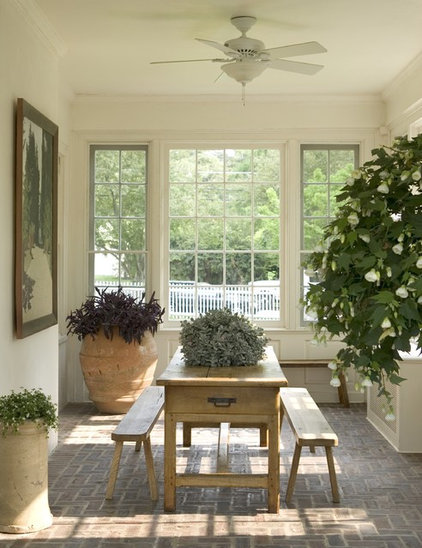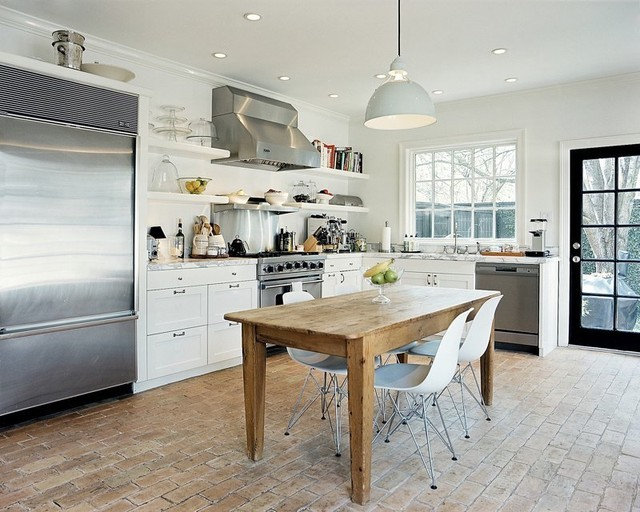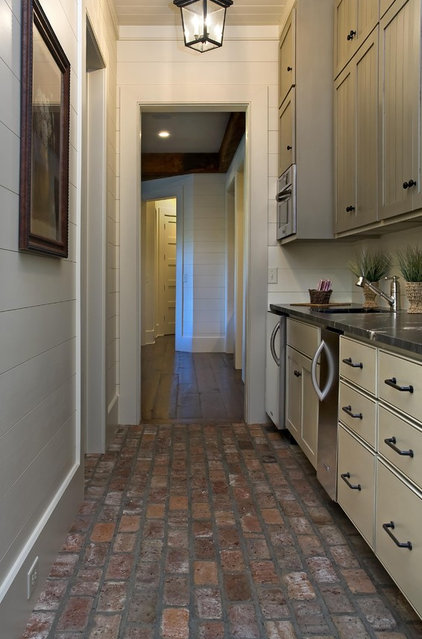Pros of Brick Flooring
• Design flexibility. As with tile, brick's modular nature lends itself to an infinite variety of patterns. Running bond (staggered), basket weave, herringbone and others are classics, but you can create a custom motif or a mosaic-style treatment. Brick also lends itself well to paint or epoxy, if you'd like a dramatically different color than the usual earth tones.
• Sturdiness. Remember theThree Little Pigs? There are good reasons brick has been a construction stalwart for centuries: It's tough to destroy, it doesn't rot. and it won't require painting or refinishing. Brick withstands extreme conditions and weathers heavy foot traffic with ease, and it's also heatproof. Individual bricks may crack or chip over time, but they are relatively easy to pry out and replace.
• Design flexibility. As with tile, brick's modular nature lends itself to an infinite variety of patterns. Running bond (staggered), basket weave, herringbone and others are classics, but you can create a custom motif or a mosaic-style treatment. Brick also lends itself well to paint or epoxy, if you'd like a dramatically different color than the usual earth tones.
• Sturdiness. Remember theThree Little Pigs? There are good reasons brick has been a construction stalwart for centuries: It's tough to destroy, it doesn't rot. and it won't require painting or refinishing. Brick withstands extreme conditions and weathers heavy foot traffic with ease, and it's also heatproof. Individual bricks may crack or chip over time, but they are relatively easy to pry out and replace.
• Affordability. Because brick used for interior applications is generally in paver or tile form, it's thinner and less costly than exterior brick. On average you'll pay less than $10 per square foot, uninstalled. Unless you're an extremely skilled DIYer, you'll need to factor in professional installation costs (usually around $500 to $700 for an average-size room), as brick can be difficult to lay correctly.
• Sustainability. Clay brick is made mostly of natural materials, such as shale, kaolin and minerals. In addition, bricks from old or demolished structures can be salvaged for new applications — particularly nice if you're aiming for a vintage effect.
• Slip resistance. Left unfinished, brick has a slightly rough, textured surface that provides traction underfoot. However, if you seal it with a slick or waxy coating, you'll have to take other steps to prevent falls.
• Aesthetic appeal. One of the reasons people love brick is its inherent traditional warmth, which few other materials can replicate. It evokes a sense of the past and feels like a strong, reassuring holdover from bygone days. Natural variations in its coloring give it a beautifully nuanced palette.
• Sustainability. Clay brick is made mostly of natural materials, such as shale, kaolin and minerals. In addition, bricks from old or demolished structures can be salvaged for new applications — particularly nice if you're aiming for a vintage effect.
• Slip resistance. Left unfinished, brick has a slightly rough, textured surface that provides traction underfoot. However, if you seal it with a slick or waxy coating, you'll have to take other steps to prevent falls.
• Aesthetic appeal. One of the reasons people love brick is its inherent traditional warmth, which few other materials can replicate. It evokes a sense of the past and feels like a strong, reassuring holdover from bygone days. Natural variations in its coloring give it a beautifully nuanced palette.
Cons of Brick Flooring
• Hardness. Durability comes with a price: Brick is unyielding beneath the feet. If you're using it in a kitchen or another space where you spend long periods of time standing, consider adding a cushioned mat or a thick rug to ease the strain on your legs and back.
• Unevenness. Even the best-laid brick floors aren't 100 percent level, so you may need to compensate by sliding shims under furniture or pads beneath precarious breakables.
• Weight. As you'd imagine, bricks are heavy, even in paver form. As a result, they're often impractical for a home's second or third story; it's very hard to reinforce the floor enough to support all that weight.
• Hardness. Durability comes with a price: Brick is unyielding beneath the feet. If you're using it in a kitchen or another space where you spend long periods of time standing, consider adding a cushioned mat or a thick rug to ease the strain on your legs and back.
• Unevenness. Even the best-laid brick floors aren't 100 percent level, so you may need to compensate by sliding shims under furniture or pads beneath precarious breakables.
• Weight. As you'd imagine, bricks are heavy, even in paver form. As a result, they're often impractical for a home's second or third story; it's very hard to reinforce the floor enough to support all that weight.
• Moisture damage. While bricks on a vertical surface resist water well, bricks on a horizontal surface are a different story. Moisture can collect and penetrate the mortar, and if the bricks are porous, it can seep beneath their surface as well. You'll want to apply a sealant periodically to guard against mildew, mold and cracking.


